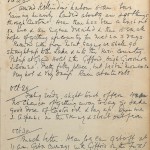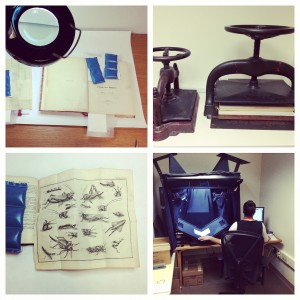It’s National Handwriting Day! The Smithsonian Field Book Project, a joint initiative between the Smithsonian Libraries, Smithsonian Institution Archives, and National Museum of Natural History to uncover, catalog, digitize, and share online the primary source records of scientific research done at, by, and for the Institution, celebrates this day with a showcase of some of the handwriting samples encountered during the project work. The Project works with materials stretching back almost 200 years, to 1816, and therefore often runs across examples of both very good and very bad handwriting.
Category: Digitization
All I want for Christmas (really) is an amaryllis in full bloom. It is lovely to see poinsettias, beautiful products of the Smithsonian Gardens Greenhouse in Suitland, Maryland, placed about the museums, but there is something special about the amaryllis as a seasonal plant. Poinsettias have become too traditional, too expected, too (well) durable.

The travel journals of A.W. Quilter document his adventures in East Africa between 1909-1911, while on safari and engaging in big game hunting. These fascinating tales are now available in the Transcription Center for volunteers to read and review. While a great deal is still unknown about Quilter, for instance was he British or not, what is known from his journal was that he was a major in the military and embarked on his African safari from Nairobi, Kenya in October of 1909. What mysteries could a transcription of his journals uncover?
We recently carved out some space in the Natural History Building for a Conservation and Digitization Annex. The Annex allows us to do low to medium level repair on site where many of our Library books are housed. Preservation staff share the space with our digitization team. The goal was to reduce the amount of shipping between our main conservation lab (located offsite in Maryland) and the majority of our materials located on the National Mall. Our main concerns were books that are very large and fragile that we are reluctant to put through the stress of packing and shipping and volumes that require simple repairs in order for them to be scanned.

The blog post, first of three, was written by Xavier Courouble, research assistant for Sailors and Daughters: Early Photography and the Indian Ocean, an online exhibition part of the Smithsonian’s National Museum of African Art’s Connecting the Gems of the Indian Ocean: From Oman to East Africa.
Recovering from loss of empire following Napoleon’s defeat at Waterloo in 1815, the French sought to re-establish commerce and colonies in the Indian Ocean. The task fell to Charles Guillain, who led a French expedition to the Swahili coast of Eastern Africa in 1846-1848. Our record of his travels is enshrined in a magisterial 3-volume work Documents sur l’histoire, la géographie, et le commerce de l’Afrique orientale and the accompanying atlas folio of engravings and maps, Voyage à la côte orientale d’Afrique.
The Smithsonian Libraries has digitized the complete work of the volumes held by the Warren M. Robbins Library at the National Museum of African Art.
In honor of Halloween and the very last day of Archives Month, we present you with this creepy cool look at an unusual printing example in our collection, one that uses the wings of real butterflies. This post was written by Daria Wingreen-Mason, Special Collections Technical Information Specialist in the Joseph F. Cullman 3rd Library of Natural History.

